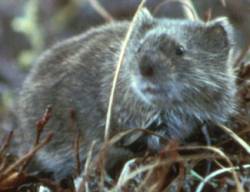
The pacarana is a rare and slow-moving hystricognath rodent indigenous to South America. Native Tupi people call it the pacarana because it is superficially similar to the paca, a different rodent which is not in the same family. The pacarana has a chunky body and is large for a rodent, weighing up to 15 kg (33 lb) and measuring up to 79 cm in length, not including the thick, furry tail.

The Arvicolinae are a subfamily of rodents that includes the voles, lemmings, and muskrats. They are most closely related to the other subfamilies in the Cricetidae. Some authorities place the subfamily Arvicolinae in the family Muridae along with all other members of the superfamily Muroidea. Some refer to the subfamily as the Microtinae or rank the taxon as a full family, the Arvicolidae.

Microtus is a genus of voles found in North America, Europe and northern Asia. The genus name refers to the small ears of these animals. About 62 species are placed in the genus. They are stout rodents with short ears, legs and tails. They eat green vegetation such as grasses and sedges in summer, and grains, seeds, root and bark at other times. The genus is also called "meadow voles".

The tundra vole or root vole is a medium-sized vole found in Northern and Central Europe, Asia, and northwestern North America, including Alaska and northwestern Canada. In the western part of the Netherlands, the tundra vole is a relict from the ice age and has developed into the subspecies Alexandromys oeconomus arenicola.

The reed vole is a species of vole. It is found in northern and central Eurasia, including northern China and the Korean Peninsula. This species is somewhat larger and longer-tailed than most other voles.
The Awash multimammate mouse or Awash mastomys is a species of rodent in the family Muridae found only in Ethiopia. Phylogentically the Awash multimammate mouse is the sister taxon of the Natal multimammate mouse, a species found almost everywhere in Africa south of the Sahara and considered a serious agricultural pest throughout its range.

The lacustrine vole is a species of rodent in the family Cricetidae. It is found in China and Mongolia.
Maximowicz's vole is a species of rodent in the family Cricetidae. It is found in northeastern China, Mongolia, and eastern Russia.
Middendorff's vole is a species of rodent in the family Cricetidae. It is found only in Russia, most commonly north Siberia.
The Mongolian vole is a species of rodent in the family Cricetidae. It is found in China, Mongolia, and Russia.
The Muya Valley vole or Muisk vole is a species of rodent in the family Cricetidae. It is found only in Russia.
The Sakhalin vole is a species of rodent in the family Cricetidae. It is found only in Russia.

The Philippine forest rat is a species of rodent in the family Muridae. It is found only in the Philippines, and is located throughout the archipelago. The scientific name commemorates British colonial administrator and zoological collector Alfred Hart Everett. The Chanum Torres is widespread throughout its range and feeds on a diet of worms and insects. There are no major threats to the species, which has been found to be competitively superior to introduced Rattus species.

The Taiwan vole is a species of rodent in the family Cricetidae, It is an endemic species of Taiwan. This species is herbivorous with a preference for the Yushan cane.

Alexandromys is a genus of voles in the subfamily Arvicolinae, formerly a subgenus of the genus Microtus. Species in this subgenus are:
Euryoryzomys macconnelli, also known as MacConnell's rice rat or MacConnell's oryzomys, is a rodent species from South America. It is found in Brazil, Colombia, Ecuador, French Guiana, Guyana, Peru, Suriname and Venezuela, where it lives in lowland tropical rainforest. It was formerly placed in the genus Oryzomys, as Oryzomys macconnelli, but in 2006 it was reclassified as the type species of the new genus Euryoryzomys.
Nephelomys caracolus, also known as the Costa Central oryzomys or caracol rice rat, is a species of rodent in the genus Nephelomys of family Cricetidae. It is found in cloud forest in the Cordillera de la Costa Central of Aragua, Miranda, and the Distrito Federal in north-central Venezuela at elevations from 1000 to 2500 m. It is nocturnal and terrestrial, and has a varied diet. In most Nephelomys species, the posterolateral palatal pits, perforations of the palate near the third molar, are conspicuous and receded into a fossa, but in N. caracolus and the Ecuadorian species N. nimbosus, the pits are much smaller.









